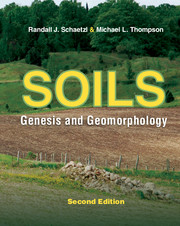8 - Soil Classification and Mapping
Published online by Cambridge University Press: 12 January 2024
Summary
Soil classification and mapping are as old as farming (Michéli and Spaargaren 2011). By 8000 BC, farmers in Europe had already determined where the better agricultural soils were and had preferentially settled on them. By 2000 BC, evidence of farming communities exists for the fertile black soils formed on the Deccan Plateau of India, but not in areas where these soils are absent (Shchetenko 1968). Clearly, early peoples were capable of assessing soil character – the essence of soil classification – and were able to use this information to differentiate the productivity of soils across the landscape. Creating physical maps of this soils knowledge would occur later. Even then, a system whereby soils could be differentiated from each other, based on their characteristics, was needed, just as it is today. Captured in this statement is the essence of soil classification.
The essence of any classification system is to place a name on a “definable entity,” in this case, a basic soil unit. Once this is done, it is possible to arrange it in an orderly system and establish its interrelationships with related entities and establish its value (Beckmann 1984). Most importantly, though, it allows for communication about the entities being classified.
Users of classification schemes agree that a name should convey the unit's unique and defined range of characteristics, whether it be a plant, e.g., Pinus sylvestris; rock, e.g., arkosic sandstone; or soil, e.g., an Aeric Fragiaquept. For soils, that range of characteristics may involve physical properties such as clay content of the B horizon, thickness of the A horizon, or color, among others. Over time, these ranges are altered and adjusted as new and more complete information about the universe of soils (or plants or rocks) accrues. Thus, most classification systems are open-ended, and periodic updates are assumed.
Before we try to classify a soil, we must first define it. We agree with Johnson (1998a), who defined soil as organic or lithic material at the surface of planets and similar bodies that has been altered by biological, chemical, and/or physical agents. But to classify soils, it is essential that we also agree on some sort of singular or basic unit (Johnson 1963). In many disciplines, it is relatively easy to determine the basic unit that is being classified: a plant, a rock, a virus.
- Type
- Chapter
- Information
- SoilsGenesis and Geomorphology, pp. 111 - 164Publisher: Cambridge University PressPrint publication year: 2015



